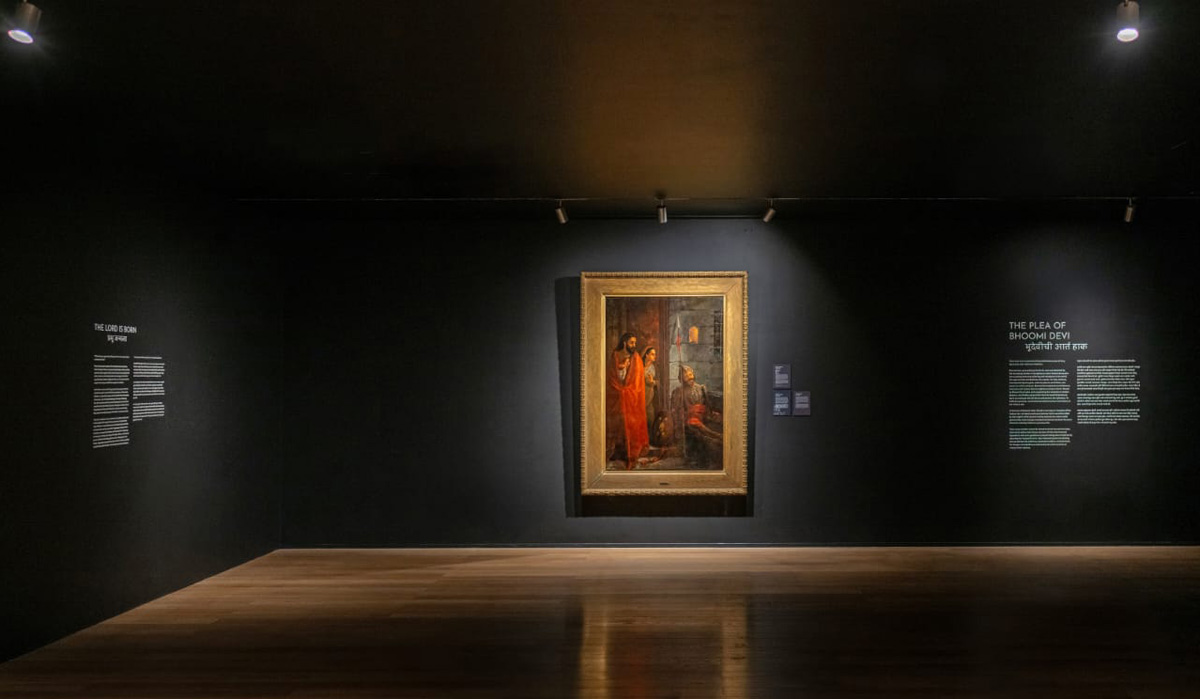From July 18 to August 18, within four storeys and 16,000 square feet of the Art House at Nita Mukesh Ambani Cultural Centre (NMACC), lies the story of Lord Krishna, depicted chronologically. The exhibition, titled Bhakti: The Art of Krishna, curated by Ashvin Rajagopalan, is one of the first of its kind. Made with a lot of Bhakti, Ashvin has thoughtfully used the four floors of the Art House, with each level dedicated to a different stage of Krishna’s life.
The exhibition has an immersive character to itself, brought to life with a multitude of artworks (revolving around Krishna’s life) by renowned artists, and the story-like descriptions that accompany them. What adds to this immersive experience is that Ashvin has used the quality of subtlety to good effect, with well-timed music (flute music) and playing around with the lighting.
The exhibition begins on Level 4. The room is dark. When asked about the reason for this ambience, Ashvin said that he wanted to try his best to capture the circumstances surrounding Krishna’s birth, which was in a prison cell, to parents Devaki and Vasudeva. They were imprisoned by Devaki’s brother, Kamsa, the King of Mathura, based on a prophecy foretelling that Kamsa would be killed by Devaki’s eighth child.
The only artwork featured in this level is that of the acclaimed Raja Ravi Varma, who received patronage from the Gaekwad rulers of the princely state of Baroda (Vadodara), particularly Maharaja Sayajirao Gaekwad III. This artwork, featuring Vasudeva, Devaki and Krishna as a baby, lays a strong foundation for everything that is to follow in the story of Krishna. The size of the painting is worth bearing witness to.
Level 3 covers the early life of Krishna. From depicting the mother-son bond between Krishna and Yashoda, his playful nature, his love for cows, to his victories in battle, this level is filled with artworks by several notable artists. Some of these artists include Manjit Bawa, Jamini Roy, M.F. Hussain, Allah Bux and Raqib Shaw. What I found to be very interesting is that there are so many different art forms and styles in which Krishna has been depicted. To name a few, these would include the Bengal School and Thanjavur style. The artworks on this level were created using a variety of techniques, such as oil-on-canvas, lithography, print-on-paper and so on. In featuring artworks by artists such as Allah Bux and M.F. Hussain, Ashvin aims to demonstrate how “Krishna transcends cultures”. According to him, this exhibition is an agnostic telling of the story of Krishna.
We then move on to Level 2 – my favourite part of the exhibition. Here, we are taken through the teachings of Lord Krishna, drawn from the Bhagavad Gita. Upon entering the room, amidst other powerful artworks, one will find verses from the Bhagavad Gita on the walls, most of which revolve around the importance of fulfilling one’s duty. This is in reference to Krishna’s conversation with Arjuna, where he imparts philosophical teachings on righteousness, duty, and the path to spiritual fulfilment amidst the battlefield of Kurukshetra, when Arjuna is filled with emotional and moral turmoil.
Then, the exhibition leads one into a small room, in which we see various artistic renditions of Krishna’s Vishwaroopa avatar, the divine form he takes on to convince Arjuna to perform his duty and make him realize that he is after all, the Creator. Ashvin’s chronological telling of the story really aided the artistic narrative, particularly in this section.
Lastly, Level 1 covers the many temples in India that are dedicated to Krishna’s life. While each temple has a deity representing Krishna, the exhibit shows how the forms in which he is represented vary throughout the country (and therefore, cultural contexts), owing to the different kinds of experiences he had in each of these locations. Initially, I was confused and asked myself how this would fit into the story of Krishna, as it were. Ashvin told me that his intent here was to illustrate “how the world has found their own Krishna”.
From his birth, to his early days, to his teachings, to the present, this exhibition is not just the story of Krishna. It is the story of Indian culture’s story with Krishna. If you find yourself in Mumbai anytime soon, it would be a good decision to come and see what Ashvin has in store.



